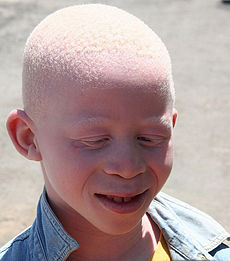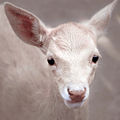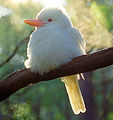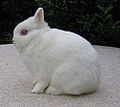- Albinism
-
"Albino" redirects here. For other uses, see Albino (disambiguation).
Albinism Classification and external resources 
A black child with albinismICD-10 E70.3 ICD-9 270.2 OMIM 203100 103470, 203200, 606952, 203290, 203300, 203310, 256710, 278400, 214450, 214500, 220900, 300500, 300600, 300650, 300700, 600501, 604228, 606574, 606952, 607624, 609227 DiseasesDB 318 MedlinePlus 001479 eMedicine derm/12 MeSH D000417 Albinism (from Latin albus, "white"; see extended etymology, also called achromia, achromasia, or achromatosis) is a congenital disorder characterized by the complete or partial absence of pigment in the skin, hair and eyes due to absence or defect of an enzyme involved in the production of melanin. Albinism results from inheritance of recessive gene alleles and is known to affect all vertebrates, including humans. While an organism with complete absence of melanin is called an albino (
 /ælˈbaɪnoʊ/,[1] or /ælˈbiːnoʊ/),[2] an organism with only a diminished amount of melanin is described as albinoid.[3]
/ælˈbaɪnoʊ/,[1] or /ælˈbiːnoʊ/),[2] an organism with only a diminished amount of melanin is described as albinoid.[3]Albinism is associated with a number of vision defects, such as photophobia, Nystagmus and astigmatism. Lack of skin pigmentation makes the organism more susceptible to sunburn and skin cancers.
Contents
Classification in humans
There are two main categories of albinism in humans:
- In oculocutaneous albinism Types 1-4 with different levels with pigmentation (despite its Latin-derived name meaning "eye-and-skin" albinism), pigment is lacking in the eyes, skin and hair. (The equivalent mutation in non-humans also results in lack of melanin in the fur, scales or feathers.) People with oculocutaneous albinism can have anything from no pigment at all to almost normal levels for a rather pale Caucasian.
- In ocular albinism, only the eyes lack pigment. People who have ocular albinism have generally normal skin and hair color, although it is typically lighter than either parent. Many even have a normal eye appearance. Also, ocular albinism is generally sex-linked, therefore males are more likely to be affected. Males are without another X chromosome to mask recessive alleles on the X they inherit.
Other conditions include albinism as part of their presentation. These include Hermansky-Pudlak syndrome, Chediak-Higashi syndrome, Griscelli syndrome, Waardenburg syndrome, and Tietz syndrome. These conditions are sometimes classified with albinism.[4] Several have sub-types. Some are easily distinguished by appearance, but in most cases genetic testing is the only way to be certain.
Albinism was formerly categorized as tyrosinase-positive or -negative. In cases of tyrosinase-positive albinism, the enzyme tyrosinase is present. The melanocytes (pigment cells) are unable to produce melanin for any one of a variety of reasons that do not directly involve the tyrosinase enzyme. In tyrosinase-negative cases, either the tyrosinase enzyme is not produced or a nonfunctional version is produced. This classification has been rendered obsolete by recent research.[5]
Signs and symptoms
 Albinistic girl from Papua New Guinea
Albinistic girl from Papua New Guinea
Most albinistic humans appear white or very pale as the melanin pigments responsible for brown, black, and some yellow colorations are not present.
Because individuals with albinism have skin that partially or entirely lacks the dark pigment melanin, which helps protect the skin from the sun's ultraviolet radiation, their skin can burn more easily from overexposure.[6]
The human eye normally produces enough pigment to color the iris and lend opacity to the eye. However, there are cases in which the eyes of an albinistic person appear red or purple, depending on the amount of pigment present. Lack of pigment in the eyes also results in problems with vision, both related and unrelated to photosensitivity.
The albinistic are generally as healthy as the rest of the population (but see related disorders below), with growth and development occurring as normal, and albinism by itself does not cause mortality,[7] although the lack of pigment blocking ultraviolet radiation increases the risk of skin cancer and other problems.[8]
Visual problems
Development of the optical system is highly dependent on the presence of melanin, and the reduction or absence of this pigment in albinistic individuals may lead to
- Misrouting of the retinogeniculate projections, resulting in abnormal decussation (crossing) of optic nerve fibres[6]
- Photophobia and decreased visual acuity due to light scattering within the eye (ocular straylight)[6][9]
- Reduced visual acuity due to foveal hypoplasia and possibly light-induced retinal damage[6]
Eye conditions common in albinism include:
- Nystagmus, irregular rapid movement of the eyes back and forth, or in circular motion.[6]
- Refractive errors such as myopia or hyperopia and especially astigmatism[10]
- Amblyopia, decrease in acuity of one or both eyes due to poor transmission to the brain, often due to other conditions such as strabismus.[6]
- Optic nerve hypoplasia, underdevelopment of the optic nerve
Some of the visual problems associated with albinism arise from a poorly developed retinal pigment epithelium (RPE) due to the lack of melanin.[citation needed] This degenerate RPE causes foveal hypoplasia (a failure in the development of normal foveae), which results in eccentric fixation and lower visual acuity, and often a minor level of strabismus.
The iris is a sphincter formed from pigmented tissue that contracts when the eye is exposed to bright light, to protect the retina by limiting the amount of light passing through the pupil. In low light conditions the iris relaxes to allow more light to enter the eye. In albinistic subjects, the iris does not have enough pigment to block the light, thus the decrease in pupil diameter is only partially successful in reducing the amount of light entering the eye.[citation needed] Additionally, the improper development of the RPE, which in normal eyes absorbs most of the reflected sunlight, further increases glare due to light scattering within the eye.[11] The resulting sensitivity (photophobia) generally leads to discomfort in bright light, but this can be reduced by the use of sunglasses and/or brimmed hats.[5]
Genetics
Most forms of albinism are the result of the biological inheritance of genetically recessive alleles (genes) passed from both parents of an individual, though some rare forms are inherited from only one parent. There are other genetic mutations which are proven to be associated with albinism. All alterations, however, lead to changes in melanin production in the body.[7][12]
The chance of offspring with albinism resulting from the pairing of an organism with albinism and one without albinism is low. However, because organisms can be carriers of genes for albinism without exhibiting any traits, albinistic offspring can be produced by two non-albinistic parents. Albinism usually occurs with equal frequency in both genders.[7] An exception to this is ocular albinism, which it is passed on to offspring through X-linked inheritance. Thus, ocular albinism occurs more frequently in males as they have a single X and Y chromosome, unlike females, whose genetics are characterized by two X chromosomes.[13]
There are two different forms of albinism; a partial lack of the melanin is known as hypomelanism, or hypomelanosis and the total absence of melanin is known as amelanism or amelanosis.
Diagnosis
Genetic testing can confirm albinism and what variety it is, but offers no medical benefits except in the cases of non-OCA disorders (see below) that cause albinism along with other medical problems which may be treatable. The symptoms of albinism can be treated by various methods detailed below.
Treatment
For the most part, treatment of the eye conditions consists of visual rehabilitation.[citation needed] Surgery is possible on the ocular muscles to decrease nystagmus, strabismus and common refractive errors like astigmatism.[6] Strabismus surgery may improve the appearance of the eyes.[citation needed] Nystagmus-damping surgery can also be performed, to reduce the "shaking" of the eyes back and forth.[14] The effectiveness of all these procedures varies greatly and depends on individual circumstances. More importantly, since surgery will not restore a normal RPE or foveae, surgery will not provide fine binocular vision.[citation needed] In the case of esotropia (the "crossed eyes" form of strabismus), surgery may help vision by expanding the visual field (the area that the eyes can see while looking at one point).[citation needed]
Glasses and other vision aids, large-print materials and CCTV, as well as bright but angled reading lights, can help individuals with albinism, even though their vision cannot be corrected completely. Some people with Albinism do well using bifocals (with a strong reading lens), prescription reading glasses, and/or hand-held devices such as magnifiers or monoculars (a very simple telescope).[5] Contact lenses may be colored to block light transmission through the iris. But in case of nystagmus this is not possible, due to the irritation that is caused by the movement of the eyes. Some use bioptics, glasses which have small telescopes mounted on, in, or behind their regular lenses, so that they can look through either the regular lens or the telescope. Newer designs of bioptics use smaller light-weight lenses. Some US states allow the use of bioptic telescopes for driving motor vehicles. (See also NOAH bulletin "Low Vision Aids".)
Epidemiology
Albinism affects people of all ethnic backgrounds; its frequency worldwide is estimated to be approximately one in 17,000. Prevalence of the different forms of albinism varies considerably by population, and is highest overall in people of sub-Saharan African descent.[15]
Society and culture
Main articles: Persecution of people with albinism and Albinism in popular cultureIn physical terms, humans with albinism commonly have vision problems and need sun protection. But they also face social and cultural challenges (even threats) as the condition is often a source of ridicule, discrimination, or even fear and violence. Cultures around the world have developed many beliefs regarding people with albinism. This folklore ranges from harmless myth to dangerous superstitions that cost human lives. Cultural challenges can be expected to be vastly higher in areas where pale skin and light hair stand out more from the ethnic majority's average phenotype.
In African countries such as Tanzania[16] and Burundi,[17][18] there has been an unprecedented rise in witchcraft-related killings of albino people in recent years. This is because albino body parts are used in potions sold by witchdoctors. Numerous authenticated incidents have occurred in Africa during the 21st Century.[19][20][21][22] For example, in Tanzania, in September 2009, three men were convicted of killing a 14-year-old albino boy and severing his legs in order to sell them for witchcraft purposes.[23] Again in Tanzania and Burundi in 2010, the murder and dismemberment of a kidnapped albino child is reported from the courts,[17] as part of a continuing problem.
Other examples: In Zimbabwe, belief that sex with an albinistic woman will cure a man of HIV has led to rapes (and subsequent HIV infection).[24]
Certain ethnic groups and insular areas exhibit heightened susceptibility to albinism, presumably due to genetic factors (reinforced by cultural traditions). These include notably the Native American Kuna and Zuni nations (respectively of Panama and New Mexico); Japan, in which one particular form of albinism is unusually common; and Ukerewe Island, the population of which shows a very high incidence of albinism.[25]
A number of people with albinism have become famous, including historical figures such as Emperor Seinei of Japan, and Oxford don William Archibald Spooner; actor-comedian Victor Varnado; musicians such as Johnny and Edgar Winter, Salif Keita, Winston "Yellowman" Foster, Brother Ali, Sivuca, Willie "Piano Red" Perryman; and fashion model Connie Chiu.
There have also been some famed albino animals, including Migaloo, a humpback whale off the coast of Australia; an albino Bottlenose dolphin named Pinky living in & around in Calcasieu Lake, Louisiana, Snowflake, a gorilla from a zoo in Barcelona; Snowdrop, a Bristol Zoo penguin; and an albino buffalo known as Mahpiya Ska which is Sioux for White Cloud, in Jamestown, ND.[26] and the sperm whale Mocha Dick, the inspiration for Herman Melville's novel Moby-Dick.
In other animals
Many animals with albinism lack their protective camouflage and are unable to conceal themselves from their predators or prey; the survival rate of animals with albinism in the wild is usually quite low.[27][28] However the novelty of albino animals has occasionally led to their protection by groups such as the Albino Squirrel Preservation Society.
In partial albinism there can be a single patch or patches of skin that lack melanin. Especially in albinistic birds and reptiles, ruddy and yellow hues or other colors may be present on the entire body or in patches (as is common among pigeons), because of the presence of other pigments unaffected by albinism such as porphyrins, pteridines and psittacins, as well as carotenoid pigments derived from the diet.
In some animals albinism-like conditions may affect other pigments or pigment-production mechanisms:
- "Whiteface" a condition that affect some parrot species is caused by a lack of psittacins.[29]
- Axanthism is a condition common in reptiles and amphibians, in which xanthophore metabolism is affected rather than synthesis of melanin, resulting in reduction or absence of red and yellow pteridine pigments.[30]
- Leucism differs from albinism in that the melanin is, at least, partially absent but the eyes retain their usual color. Some leucistic animals are white or pale because of chromatophore (pigment cell) defects, and do not lack melanin.
- Melanism is the direct opposite of albinism. An unusually high level of melanin pigmentation (and sometimes absence of other types of pigment in species that have more than one) results in an appearance darker than non-melanistic specimens from the same genepool.[31]
Intentionally bred albinistic strains of some animal species are commonly used as model organisms in biomedical study and experimentation, although some researchers have argued that they are not always the best choice.[32] Examples include the BALB/c mouse and Wistar and Sprague Dawley rat strains, while albino rabbits were historically used for Draize toxicity testing.[33] The yellow mutation in fruit flies is their version of albinism.
The incidence of albinism can be artificially increased in fish by exposing the eggs to heavy metals (arsenic, cadmium, copper, mercury, selenium, zinc).[34]
The eyes of an albino animal appear red because the colour of the red blood cells in the underlying retinal blood vessels shows through where there is no pigment to obscure it.
-
Albino Red-necked Wallaby
-
An albino Wistar rat, a strain commonly used for both biomedical and basic research.
-
Albino deer
-
An Albino American Alligator
-
European Mole (Talpa europaea Linnaeus, 1758)
-
An Albino Kookaburra
-
An albino individual of freshwater snail Biomphalaria glabrata. All snails in the family Planorbidae have the red oxygen transport pigment haemoglobin, but this is especially apparent in albino animals.
See also
- Albinism–deafness syndrome
- Vitiligo (or leukoderma), patchy loss of dermal pigmentation
- Piebaldism, patchy alternating loss of and concentrations of dermal pigmentation
- Xanthochromism and axanthism, unusually yellow pigmentation and lack of yellow pigment, respectively
- Erythrism, unusually red pigmentation
- Nevus, or birthmark
- Human variability
- List of cutaneous conditions
- List of Mendelian traits in humans
References
- ^ "Albino" Dictionary.com. Accessed May 11, 2011
- ^ "Pronunciation of albino" Macmillan Dictionary. Accessed May 11, 2011
- ^ Tietz, W. A Syndrome of Deaf-Mutism Associated with Albinism Showing Dominant Autosomal Inheritance. Department of Pediatrics, Southern California.
- ^ "ILDS - ICD10". http://web.ilds.org/icd10_list.php?VIEW=1&START_CODE=E70.3&START_EXT=14.
- ^ a b c "Facts about Albinism", by Dr. Richard King et al.
- ^ a b c d e f g Chen, Harold (2006). Atlas of genetic diagnosis and counseling. Totowa, NJ: Humana Press. pp. 37–40. ISBN 1-58829-681-4. http://books.google.com/?id=2VcdAXJ_dZkC&pg=PA36&dq=Albinism&q=Albinism. Retrieved 22 July 2010.
- ^ a b c "Albinism", by Dr. Raymond E. Boissy, Dr. James J. Nordlund, et al., at eMedicine, 22 August 2005. Retrieved 31 March 2007.
- ^ Philippine General Hospital. "Albino People - Albinism in Humans". http://www.albinopeople.org/.
- ^ Kruijt B et al. "Ocular straylight in albinism". Optom Vis Sc 2011;88:E585-E592
- ^ Carden SM, Boissy RE, Schoettker PJ, Good WV (February 1998). "Albinism: modern molecular diagnosis". The British Journal of Ophthalmology 82 (2): 189–95. doi:10.1136/bjo.82.2.189. PMC 1722467. PMID 9613388. http://www.pubmedcentral.nih.gov/articlerender.fcgi?tool=pmcentrez&artid=1722467.
- ^ "Albinism—Review of Optometry Online".
- ^ Online Mendelian Inheritance in Man, at Johns Hopkins University (see also Mendelian Inheritance in Man for more information about this source).
- ^ "Sex-linked recessive", by Chad Haldeman-Englert, MD, Division of Human Genetics, Children's Hospital of Philadelphia, Philadelphia, PA
- ^ Lee J (May 2002). "Surgical management of nystagmus". Journal of the Royal Society of Medicine 95 (5): 238–41. doi:10.1258/jrsm.95.5.238. PMC 1279676. PMID 11983764. http://www.pubmedcentral.nih.gov/articlerender.fcgi?tool=pmcentrez&artid=1279676.
- ^ Gronskov K, Ek J, Brondum-Nielsen K (2 November 2007). "Oculocutaneous albinism". Orphanet Journal of Rare Diseases. doi:10.1186/1750-1172-2-43. PMC 2211462. PMID 17980020. http://www.pubmedcentral.nih.gov/articlerender.fcgi?tool=pmcentrez&artid=2211462.
- ^ "Africa | Living in fear: Tanzania's albinos". BBC News. 2008-07-21. http://news.bbc.co.uk/1/hi/world/africa/7518049.stm. Retrieved 27 February 2010.
- ^ a b "Burundi albino boy 'dismembered'". BBC News. 24 October 2010. http://www.bbc.co.uk/news/world-africa-11614957.
- ^ "Africa | Burundian albino murders denied". BBC News. 2009-05-19. http://news.bbc.co.uk/1/hi/world/africa/8057956.stm. Retrieved 27 February 2010.
- ^ "Africa | Man 'tried to sell' albino wife". BBC News. 2008-11-13. http://news.bbc.co.uk/1/hi/world/africa/7726743.stm. Retrieved 27 February 2010.
- ^ "Africa | Tanzania albinos targeted again". BBC News. 2008-07-27. http://news.bbc.co.uk/1/hi/world/africa/7527729.stm. Retrieved 27 February 2010.
- ^ Ntetema, Vicky (2008-07-24). "Africa | In hiding for exposing Tanzania witchdoctors". BBC News. http://news.bbc.co.uk/1/hi/world/africa/7523796.stm. Retrieved 27 February 2010.
- ^ "Africa | Mothers hacked in albino attacks". BBC News. 2008-11-14. http://news.bbc.co.uk/1/hi/world/africa/7730193.stm. Retrieved 27 February 2010.
- ^ "Death for Tanzania albino killers". BBC News. 2009-09-23. http://news.bbc.co.uk/1/hi/world/africa/8270446.stm. Retrieved 27 February 2010.
- ^ Machipisa, Lewis. "RIGHTS-ZIMBABWE: The Last Minority Group to Find a Voice". Inter Press Service News Agency. IPS-Inter Press Service. http://ipsnews.net/interna.asp?idnews=14122. Retrieved 30 January 2010.
- ^ Anon (2009). "Ukerewe Albino Society". southern-africas-children.org.uk/. Southern Africas Children. http://www.southern-africas-children.org.uk/ukerewe-albino.html. Retrieved 21 July 2010.
- ^ "Rare Pink Dolphin Seen in Louisiana Lake - Science News | Science & Technology | Technology News". FOXNews.com. 2007-07-03. http://www.foxnews.com/story/0,2933,287938,00.html. Retrieved 27 February 2010.
- ^ Ilo Hiler, Albinos. Young Naturalist. The Louise Lindsey Merrick Texas Environment Series, No. 6, pp. 28–31. Texas A&M University Press, College Station (1983)
- ^ Dobosz, ByS; Kohlmann, K.; Goryczko, K.; Kuzminski, H. (July 2008). "Growth and vitality in yellow forms of rainbow trout". Journal of Applied Ichthyology 16 (3): 117–20. doi:10.1111/j.1439-0426.2000.00147.x (inactive 2010-02-16).
- ^ "The Parblue Puzzle: Part 4—Common Parblue Varieties: The Cockatiel [Nymphicus hollandicus]" by Clive Hesford, The Genetics of Colour in the Budgerigar and Other Parrots, January 1998
- ^ "Amphibian Biology & Physiology: Caudata" at Amphibian Information Resource: An Educational Web Project About Amphibian Species; sourced December 2006, actual authoring/publication date unspecified.
- ^ "Feather Colors: What We See" by Dr. Julie Feinstein of the American Museum of Natural History (NY), in Birder's World Magazine online archive; sourced December 2006, actual authoring/publication date unspecified.
- ^ Creel D (June 1980). "Inappropriate use of albino animals as models in research". Pharmacology, Biochemistry, and Behavior 12 (6): 969–7. doi:10.1016/0091-3057(80)90461-X. PMID 7403210.
- ^ Draize, J.H., Woodard, G. and Calvery, H.O. (1944). "Methods for the study of irritation and toxicity of substances applied topically to the skin and mucous membranes". J. Pharmacol. and Exp. Therapeutics. 82: 377–390.
- ^ Brito, Marcelo F. G. de; Caramaschi, ÉRica P. (2005). "An albino armored catfish Schizolecis guntheri (Siluriformes: Loricariidae) from an Atlantic Forest coastal basin". Neotropical Ichthyology 3. doi:10.1590/S1679-62252005000100009.
External links
- GeneReview/NCBI/NIH/UW entry on Oculocutaneous Albinism Type 1[clarification needed]
- GeneReview/NCBI/NIH/UW entry on Oculocutaneous Albinism Type 2[clarification needed]
- GeneReview/NCBI/NIH/UW entry on Oculocutaneous Albinism Type 4[clarification needed]
Pigmentation disorders/Dyschromia (L80–L81, 709.0) Hypo-/
leucismLoss of melanocytesvitiligo: Quadrichrome vitiligo · Vitiligo ponctué · syndromic (Alezzandrini syndrome · Vogt–Koyanagi–Harada syndrome)
melanocyte development: Piebaldism · Waardenburg syndrome · Tietz syndromeLoss of melanin/
amelanismalbinism: Oculocutaneous albinism · Ocular albinism
melanosome transfer: Hermansky–Pudlak syndrome · Chédiak–Higashi syndrome · Griscelli syndrome (Elejalde syndrome · Griscelli syndrome type 2 · Griscelli syndrome type 3)
other: Cross syndrome · ABCD syndrome · Albinism–deafness syndrome · Idiopathic guttate hypomelanosis · Phylloid hypomelanosis · Progressive macular hypomelanosisLeukoderma w/o
hypomelanosisUngroupedungrouped: Nevus depigmentosus · Postinflammatory hypopigmentation · Pityriasis alba · Vagabond's leukomelanoderma · Yemenite deaf-blind hypopigmentation syndrome · Wende–Bauckus syndromeHyper- ReticulatedDermatopathia pigmentosa reticularis · Pigmentatio reticularis faciei et colli · Reticulate acropigmentation of Kitamura · Reticular pigmented anomaly of the flexures · Naegeli–Franceschetti–Jadassohn syndrome · Dyskeratosis congenita · X-linked reticulate pigmentary disorder · Galli–Galli disease · Revesz syndromeDiffuse/
circumscribedLentigo/Lentiginosis: Lentigo simplex · Liver spot · Centrofacial lentiginosis · Generalized lentiginosis · Inherited patterned lentiginosis in black persons · Ink spot lentigo · Lentigo maligna · Mucosal lentigines · Partial unilateral lentiginosis · PUVA lentigines
Melasma · Erythema dyschromicum perstans · Lichen planus pigmentosus · Café au lait spot · Poikiloderma (Poikiloderma of Civatte · Poikiloderma vasculare atrophicans) · Riehl melanosisLinearOther/ungroupedAcanthosis nigricans (Acral acanthotic anomaly) · Freckle · Familial progressive hyperpigmentation · Pallister–Killian syndrome · Periorbital hyperpigmentation · Photoleukomelanodermatitis of Kobori · Postinflammatory hyperpigmentation · Transient neonatal pustular melanosisOther
pigmentsiron: Hemochromatosis · Iron metallic discoloration · Pigmented purpuric dermatosis (Schamberg disease, Majocchi's disease, Gougerot–Blum syndrome, Doucas and Kapetanakis pigmented purpura/Eczematid-like purpura of Doucas and Kapetanakis, Lichen aureus, Angioma serpiginosum) · Hemosiderin hyperpigmentationother metals: Argyria · Chrysiasis · Arsenic poisoning · Lead poisoning · Titanium metallic discolorationDyschromatoses Dyschromatosis symmetrica hereditaria · Dyschromatosis universalis hereditariaCategories:- Albinism
- Dermatologic terminology
- Portuguese loanwords
Wikimedia Foundation. 2010.










